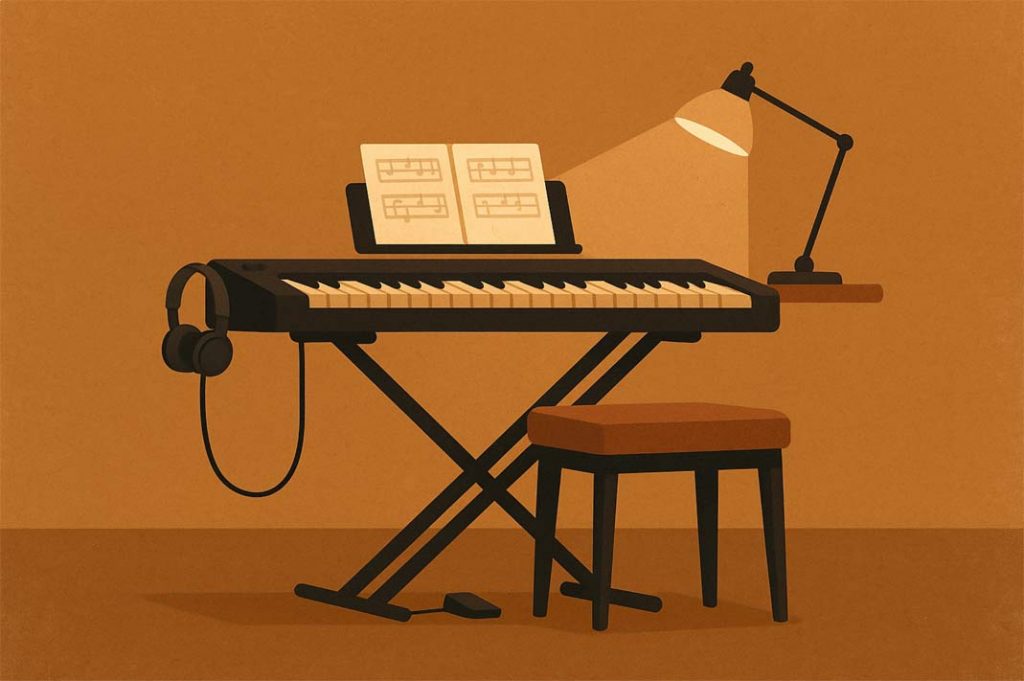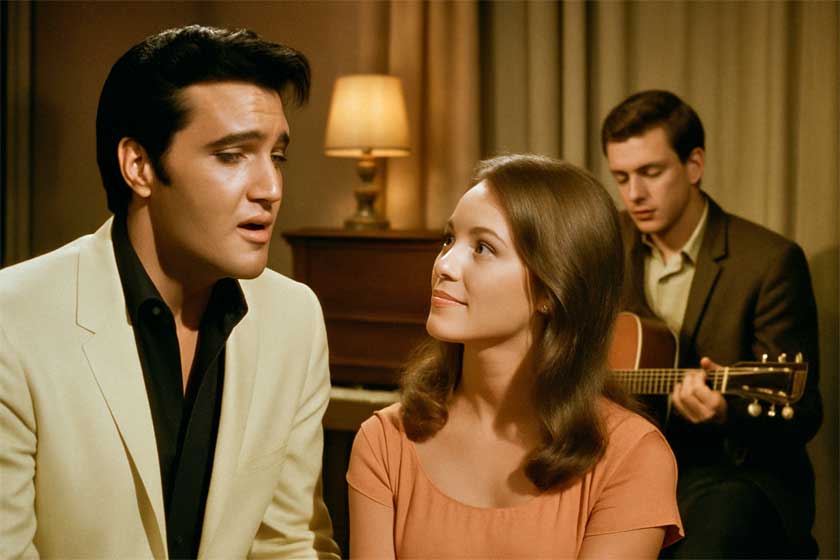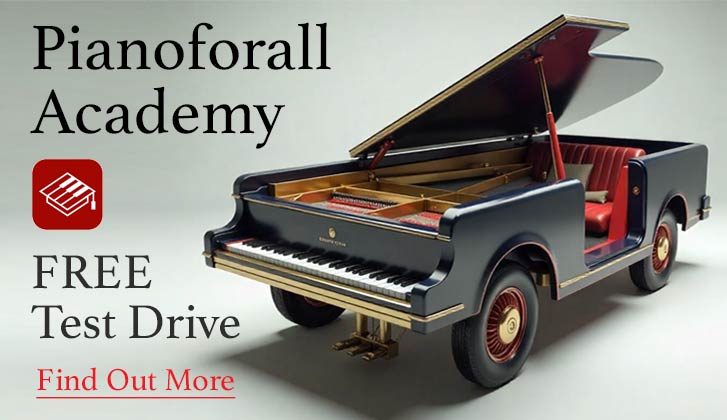Last updated: 17 September 2025
Quick start
- Take the Free Test Drive and do one 2–5 minute lesson today.
- Pick one path (Rhythm → Blues → Jazz → Classics by Ear) and stick with it for two weeks.
- Practise 15–25 minutes, five days a week—slow micro-loops first, then build speed.
Who this is for
Adult beginners, rusty returners, and readers who want to play by ear. If you want real-world music fast without wading through years of notation first, this is built for you.
Contents
- The ‘play first’ idea
- What the first weeks feel like
- What you actually learn
- Reading and ear together
- How a lesson works (start to finish)
- How practice works here
- Common sticking points (and fixes)
- What you get
- Who this is for
- How it compares
- Related guides
- Questions people ask
- Next steps
The ‘play first’ idea
We start by playing. This is an adult beginner piano course that uses a chord‑based piano method. You learn simple chords and steady rhythm so your hands make a good sound early. When that feels normal, we show how the music looks on the page. Reading then matches what you can already play and hear.
What the first weeks feel like
Short, regular sessions work best. Fifteen to twenty‑five minutes, most days. We take one small idea, try it slowly, and use it on a song you know. No long drills before you play anything. You will be playing from day one. It may be rough at first. That is normal. It improves quickly when you keep sessions short and steady.
What you actually learn
Chords. Chords are the building blocks of most music. We start with easy shapes and smooth changes. You’ll recognise common progressions and use shared notes so moves feel tidy. Later we add simple colour notes when they help the sound.
Rhythm styles. A few clear patterns for pop, ballads and blues. We keep the left hand steady and teach the right hand to fit melody or simple fills. One pattern can work for many songs with small timing changes.
Blues and basic improvising. A small set of safe notes, where to place them, and a clean way to finish a phrase. The left hand stays simple while the right hand tries short ideas that fit.
Jazz basics. Quick moves that make chords sound a bit jazzy straight away: shell shapes, adding a 7th when it helps, and a light swing feel. No heavy theory. Just shapes you can use now.
Ballads. How to turn block chords into a gentle broken‑chord flow. How to use the pedal so it rings but does not blur. How to keep the bass clear.
Classics by ear. Short, familiar classical pieces (Satie, some Bach, a touch of Moonlight). First by ear, then a little reading to back it up. It is a simple way to play a real piece without months of exercises first.
Reading and ear together
We do both. First you hear it and feel it. Then we show the notes. We start with rhythm reading you can clap. Then we match notes to shapes you already know. Over time you can follow a score when you want, play from a lead sheet, or play from chords and memory when you prefer.
How a lesson works (start to finish)
Each lesson is small and practical. You watch a short demo, then copy it slowly with me. We loop two bars until the hands feel calm. We count or clap once so the rhythm is clear. We add one small change (a held note, a tie, or a simple fill). You record a 20–30 second clip on your phone so you can hear it back. You make a quick note of what worked, then stop while it still feels tidy. Next time, we pick up from there.
How practice works here
Keep it simple. Loop a very small bit (even 10–20 seconds). Go slow enough to stay relaxed. When that feels tidy, play at a steady pace. A quiet metronome can help. Recording a short phone clip can help too because you hear things you miss while playing. Aim for clear, small wins you can hear the next day.
Common sticking points (and fixes)
- Chord changes feel clunky. Keep one finger in place when you can. Move the others the shortest distance. Practise the move slowly, both hands soft.
- Right hand feels stiff. Add one note slightly before the beat or tie one note across the beat. Small changes help the feel without making it hard.
- Pedal is messy. Change pedal when the chord changes. Lift‑down quickly so it joins without blur.
- I lose time when I add the left hand. Practise the left hand alone until it is automatic. Bring the right hand back quietly. Keep the volume low while you join them.
What you get
Instant access to an easy online course player that works on any device. It remembers where you were, lets you change playback speed, and makes it simple to rewatch a small part. You also get downloadable ebooks with video and audio built in, so you can learn offline if your internet is poor. You pay once per course and keep access for life. There’s a straightforward money‑back guarantee if it isn’t for you.
Who this is for
Adults who want to play songs without getting lost. People who tried lessons before and stopped. Singers or guitarists who want to back themselves on piano. If you like a plain, steady approach, this will suit you.
How it compares
If you are choosing between different apps and courses, this page will help: Pianoforall vs the top apps.
Related guides
Questions people ask
What ages is this for? It is written for adults. Keen teens cope well. For younger kids, a child‑centred course is usually better.
I am a complete beginner. Is it too hard? No. It is built for beginners. Small steps. Short lessons. Plain words.
Do I need a MIDI keyboard? No. Any acoustic or digital piano is fine. MIDI can help some apps, but this course does not need it.
Will I learn to read music? Yes, but not first. We add reading when your hands already know the shapes. It sticks better that way.
Is there a money‑back guarantee? Yes. If it is not for you, you can ask for a refund. Details are on the checkout page.
Can I use this with a private teacher? Yes. Many students learn songs here and take questions to a local teacher for extra help.
Can I take a break? Yes. There is no time limit. Your place is saved and you keep access.
Next steps
Try a lesson and see how it feels: take the free Test Drive. Then pick one path—Rhythm, Blues, Jazz, or Classics by Ear—and stick with it for two weeks.
To sum up
- Play first, read alongside—so you sound musical early.
- Tiny steps, tight loops, steady progress.
- Learn pop foundations, then branch to blues, jazz and classical.
- Lifetime access; pause and resume without losing momentum.






